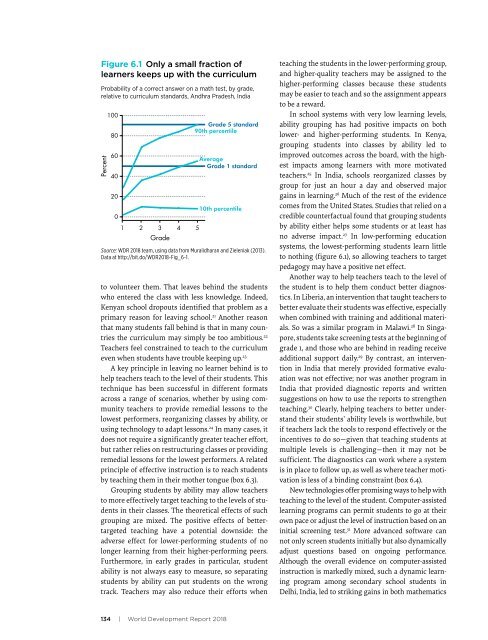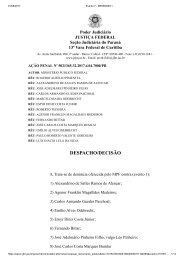Brasil só deve dominar Leitura em 260 anos, aponta estudo do Banco Mundial Relatorio Banco Mundial _Learning
Create successful ePaper yourself
Turn your PDF publications into a flip-book with our unique Google optimized e-Paper software.
Figure 6.1 Only a small fraction of<br />
learners keeps up with the curriculum<br />
Probability of a correct answer on a math test, by grade,<br />
relative to curriculum standards, Andhra Pradesh, India<br />
Percent<br />
100<br />
80<br />
60<br />
40<br />
20<br />
0<br />
1 2 3 4 5<br />
Grade<br />
Grade 5 standard<br />
90th percentile<br />
Average<br />
Grade 1 standard<br />
10th percentile<br />
Source: WDR 2018 team, using data from Muralidharan and Zieleniak (2013).<br />
Data at http://bit.<strong>do</strong>/WDR2018-Fig_6-1.<br />
to volunteer th<strong>em</strong>. That leaves behind the students<br />
who entered the class with less knowledge. Indeed,<br />
Kenyan school dropouts identified that probl<strong>em</strong> as a<br />
primary reason for leaving school. 21 Another reason<br />
that many students fall behind is that in many countries<br />
the curriculum may simply be too ambitious. 22<br />
Teachers feel constrained to teach to the curriculum<br />
even when students have trouble keeping up. 23<br />
A key principle in leaving no learner behind is to<br />
help teachers teach to the level of their students. This<br />
technique has been successful in different formats<br />
across a range of scenarios, whether by using community<br />
teachers to provide r<strong>em</strong>edial lessons to the<br />
lowest performers, reorganizing classes by ability, or<br />
using technology to adapt lessons. 24 In many cases, it<br />
<strong>do</strong>es not require a significantly greater teacher effort,<br />
but rather relies on restructuring classes or providing<br />
r<strong>em</strong>edial lessons for the lowest performers. A related<br />
principle of effective instruction is to reach students<br />
by teaching th<strong>em</strong> in their mother tongue (box 6.3).<br />
Grouping students by ability may allow teachers<br />
to more effectively target teaching to the levels of students<br />
in their classes. The theoretical effects of such<br />
grouping are mixed. The positive effects of bettertargeted<br />
teaching have a potential <strong>do</strong>wnside: the<br />
adverse effect for lower-performing students of no<br />
longer learning from their higher-performing peers.<br />
Furthermore, in early grades in particular, student<br />
ability is not always easy to measure, so separating<br />
students by ability can put students on the wrong<br />
track. Teachers may also reduce their efforts when<br />
teaching the students in the lower-performing group,<br />
and higher-quality teachers may be assigned to the<br />
higher-performing classes because these students<br />
may be easier to teach and so the assignment appears<br />
to be a reward.<br />
In school syst<strong>em</strong>s with very low learning levels,<br />
ability grouping has had positive impacts on both<br />
lower- and higher-performing students. In Kenya,<br />
grouping students into classes by ability led to<br />
improved outcomes across the board, with the highest<br />
impacts among learners with more motivated<br />
teachers. 25 In India, schools reorganized classes by<br />
group for just an hour a day and observed major<br />
gains in learning. 26 Much of the rest of the evidence<br />
comes from the United States. Studies that relied on a<br />
credible counterfactual found that grouping students<br />
by ability either helps some students or at least has<br />
no adverse impact. 27 In low-performing education<br />
syst<strong>em</strong>s, the lowest-performing students learn little<br />
to nothing (figure 6.1), so allowing teachers to target<br />
pedagogy may have a positive net effect.<br />
Another way to help teachers teach to the level of<br />
the student is to help th<strong>em</strong> conduct better diagnostics.<br />
In Liberia, an intervention that taught teachers to<br />
better evaluate their students was effective, especially<br />
when combined with training and additional materials.<br />
So was a similar program in Malawi. 28 In Singapore,<br />
students take screening tests at the beginning of<br />
grade 1, and those who are behind in reading receive<br />
additional support daily. 29 By contrast, an intervention<br />
in India that merely provided formative evaluation<br />
was not effective; nor was another program in<br />
India that provided diagnostic reports and written<br />
suggestions on how to use the reports to strengthen<br />
teaching. 30 Clearly, helping teachers to better understand<br />
their students’ ability levels is worthwhile, but<br />
if teachers lack the tools to respond effectively or the<br />
incentives to <strong>do</strong> so—given that teaching students at<br />
multiple levels is challenging—then it may not be<br />
sufficient. The diagnostics can work where a syst<strong>em</strong><br />
is in place to follow up, as well as where teacher motivation<br />
is less of a binding constraint (box 6.4).<br />
New technologies offer promising ways to help with<br />
teaching to the level of the student. Computer-assisted<br />
learning programs can permit students to go at their<br />
own pace or adjust the level of instruction based on an<br />
initial screening test. 31 More advanced software can<br />
not only screen students initially but also dynamically<br />
adjust questions based on ongoing performance.<br />
Although the overall evidence on computer-assisted<br />
instruction is markedly mixed, such a dynamic learning<br />
program among secondary school students in<br />
Delhi, India, led to striking gains in both math<strong>em</strong>atics<br />
134 | World Development Report 2018








